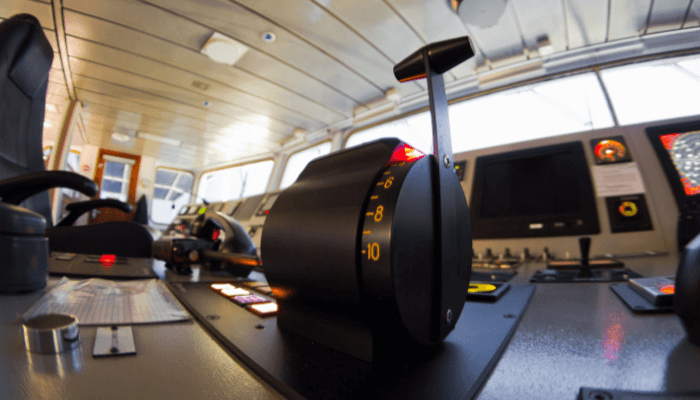

The Heart and soul of a vessel is its main engine – the sole means available and responsible for movement of vessel from one point to another, allowing it to counteract the effect of current, wind, tide and several other external factors.
As stated in COLREGS 1972 regarding the use of engines and STCW 2010 guidelines for Bridge watchkeeping, duty officers need to be fully aware and conversant with various bridge control systems and use of main engine. This know-how is essential in order to deal with emergency or critical manoeuvre wherein a thorough understanding of various alarms and indicators is required.


Below mentioned are a few basic points and cautions which deck officers must consider during operating a main engine and while going through Navigation Bridge Familiarisation:
1. Check Communication Systems: The first and the foremost important thing before using main engine is the communication between the Bridge and the Engine Control Room or the local manoeuvring platform. The fixed communication system, hand powered telephones, talk back system, walkie talkies if used should be checked and ensured in good working order at all times. Communication forms the basic and primary ingredient for starting and further operating main engine smoothly from any designated location.
2. Clear The Propeller: Before trying out or operating main engine it must be ensured that the propeller is clear of any nets , fishing lines , ropes , trawls or any other unwanted objects. Often while vessel is stopped, lying at anchor, berthed alongside a pier, jetty or berth or moored at single point mooring there are tug ropes in water or fishing nets or broken lines floating, which might get entangled in the propeller fins and damage it. Hence it’s important that such things are cleared before rotating the propeller.
3. Make Sure Engines Are Tried From ECR Before Taking Over: It is very important to ensure that the propulsion plant is in good condition so that no trouble is faced when the engine is running during manoeuvring. This can be better done by engineers who can assess the clear picture if the engine is tried for ahead and astern from ECR before transferring the controls to the bridge.
4. Test The Telegraph Transmitter: Before actually operating the Main Engine, the telegraph transmitter from the bridge is being tried out with the engine control room and its operation confirmed at both locations for starting, stopping, reversing and speed setting provided. All the indicators and push button switches, all lamps and buzzers on the main engine telegraph panel must be tried out on every occasion before commencing manoeuvring or starting the main engine.


5. Transfer the Controls and Check Indicator Lamp: The controls for operating the main engine must be provided or transferred through the command switch on the bridge telegraph panel. While changing over the control position to bridge from control station, operate the telegraph transmitter so that the indicator lamp of handle match position lights up. A navigating officer must be aware of the emergency starting interlock if the emergency shutdown is in non-operating condition.
6. Put Telegraph Transmitter Into Operational Position in Harbour Passage: During harbour passage for operating the speed control of Main Engine, telegraph transmitter can be put into optional position. The main engine speed corresponding with that position is set due to governor control. The position of telegraph transmitter is set into centre of each instruction slot; however engine speed can be changed by putting it into every other position.
7. Control Acceleration Of Main Engine Gradually When Telegraph Put Into NAV FULL: When the telegraph transmitter is put into NAV FULL position, which is at the starting position of load program, the acceleration of main engine is then controlled gradually and not instantly as per the moved position of the telegraph transmitter. Indicator lamp of LOAD PROGRAM lights up during this command. For reducing the speed of Main engine, the telegraph transmitter is moved more than from starting position of load program for reducing from NAV FULL .
8. Use PROGRAM BYPASS For Instant Reduction Or Acceleration: In case where situation demands instant reduction or acceleration of Main Engine from NAV FULL, a PROGRAM BYPASS switch is provided. Upon being pressed it will by-pass the LOAD PROGRAM for reducing or increasing the revolutions and would thus bring the main engine speed instantly to the desired position set by the Telegraph Transmitter. By pushing again the PROGRAM BYPASS switch the normal operation can be restored.
9. Know Manual Emergency Shutdown Procedure: Manual Emergency shutdown of a main engine is provided generally at following locations e.g. Bridge, Engine Control room and the Engine side. Manual emergency shutdown can be operated from any of the positions regardless of the control position for operating the Main Engine.
10. Automatic Emergency Shutdown Operates Irrespective Of Control Position: Automatic Emergency Shutdown is provided for safety in case of Overspeed and few other parameters exceeding permissible limits for a preset period of time. Once Automatic Emergency Shutdown is activated, the alarm of EMERGENCY SHUTDOWN is given and the indicator lamp flickers on the Main Engine operating panel. Automatic Emergency Shutdown too operates irrespective of the control position.
These are some of the most important points which deck officers must consider while operating the main engine from bridge.
Do you know about any other important point that can be added to this list?
Let’s know in the comments below.










We believe that knowledge is power, and we’re committed to empowering our readers with the information and resources they need to succeed in the merchant navy industry.
Whether you’re looking for advice on career planning, news and analysis, or just want to connect with other aspiring merchant navy applicants, The Marine Learners is the place to be.